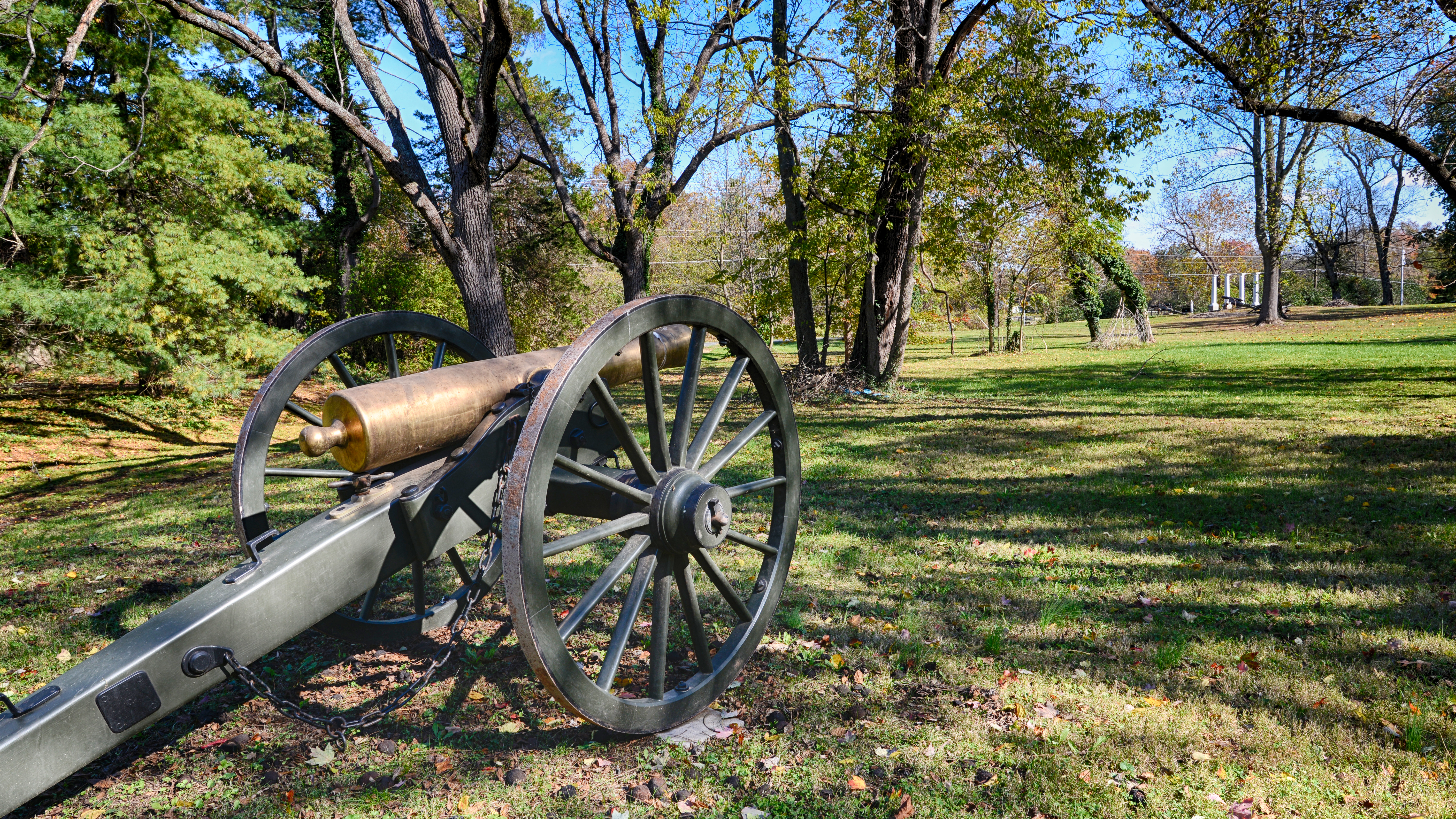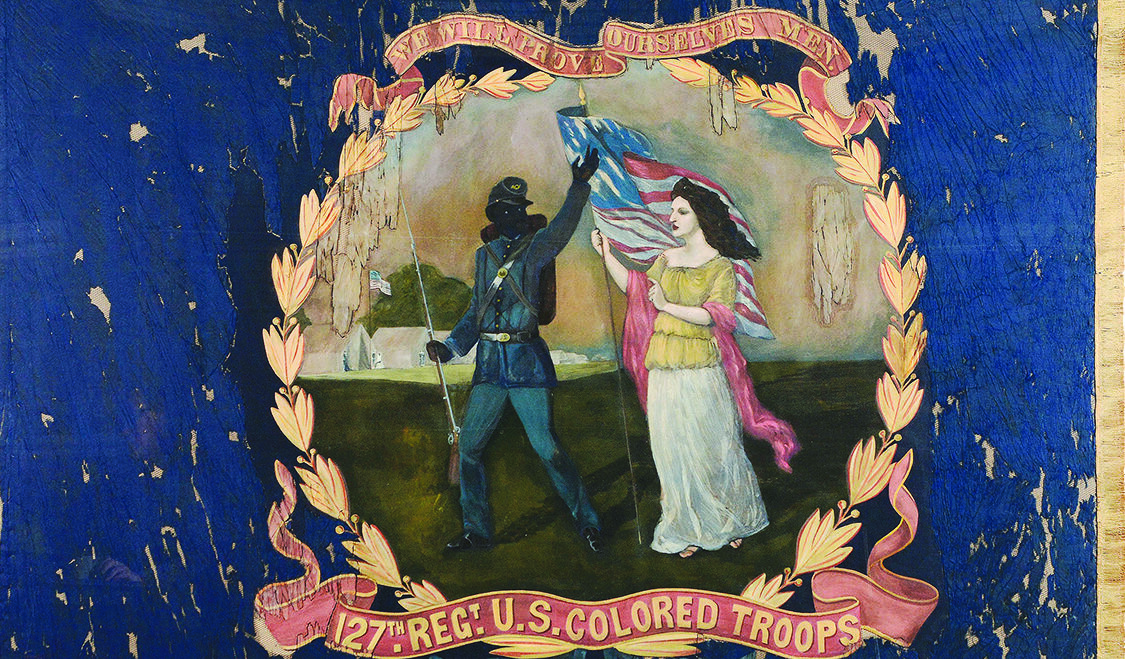[button size=”large” style=”info” color=”red”]NEWS FROM THE CIVIL WAR COMMUNITY[/button]
Atlanta History Center acquires rare USCT regimental flag
Two recent actions shed light on the important contributions made by soldiers of the United States Colored Troops during the Civil War.
[hr]In June, the Atlanta History Center purchased the regimental flag of the 127th USCT. It’s one of fewer than 25 known flags still in existence that were carried by African American regiments during the war. The silk banner, measuring72 by 55 inches, depicts a black soldier carrying a rifle and bidding farewell to Columbia, the mythical goddess of liberty. The banner’s legend reads “We Will Prove Ourselves Men.” On the reverse side, an American bald eagle holds a ribbon with the motto “E pluribus unum” (“Out of many, one.”)
The purchase price of the flag, $196,800, is the most money the History Center has ever paid for a single artifact. But Atlanta History Center President and CEO Sheffield Hale believes it was well worth it.
“We want to tell the entire story of the Civil War and how it impacts our country,” Hale said. “This flag is worth it in exhibit value alone. It’s one of those things that doesn’t need words to tell you what it is and what it represents.”
Also in June, 107 names of United States Colored Troops who served in the war were added to the names of 9,000 other Civil War veterans from Cuyahoga County, Ohio, who are already listed on the Cuyahoga County Soldiers’ and Sailors’ Monumentin Cleveland’s Public Square.
The additional names for the honor role were compiled over 17 years by Ohio history teacher Paul LaRueand his students who researched USCT enlistment and burial records among other resources.
Civil War–era plant research finds possible applications today
Bacteria resistance to antibiotics, particularly so-called “superbugs,” has proved a challenge in modern medicine. But now, according to research paper published earlier this year by scientists from Emory University in Georgia, remedies may come from a surprising arena—Civil War–era plant medicines.
Owing to the Union blockade in 1863, medicines such as quinine, morphine, and chloroform—critical in the battle against disease and infection—couldn’t reach Confederate physicians, and soldiers died in record numbers. The surgeon general of the Confederacy, Samuel Moore, turned to botanist Francis Porcher to create a field guide to medicinal plants growing in Southern states, with plant remedies used by Native Americans and enslaved Africans. Porcher’s resulting book, Resources of the Southern Fields and Forests, included 37 plants that function as antiseptics, and was issued to Confederate battlefield physicians.
Using Porcher’s book as their guide, the Emory researchers collected samples from three species cited for their use as antiseptics: two hardwoods, tulip poplar and white oak, and a shrub, devil’s walking stick. Extracts from the plants were then tested against three drug-resistant bacteria commonly found in wound infections: Staphylococcus aureus, Klebsiella pneumoniae, and Acinetobacter baumannii—the last better known as “Iraqibacter” due to its association with wounded soldiers returning from the Iraq War.
The results were pronounced: the white oak extracts inhibited growth in all three species of bacteria, and both the white oak and tulip poplar extracts inhibited Staphylococcus aureus from forming biofilms, the component that allows bacteria to coat surfaces and spread and is a particular bane to hospitals and other medical facilities.
A next step is to test the antibacterial abilities of other plants cited in Porcher’s book as antiseptics.
First author and Emory research specialist Micah Dettweiler said: “Our research might one day benefit modern wound care, if we can identify which compounds are responsible for the antimicrobial activity.”
Five Key Sites in Northern Virginia Preserved Through 1863 Fund
Five Civil War historic sites in Loudoun County, Va., will be preserved owing to an 1863 Fund, an endowment administered by the Northern Virginia Regional Park Authority (NOVA Parks).

The landmarks, all along U.S. Route 50, are the Mount Defiance Historic Park, the setting of the Battle of Middleburg; Aldie Mill Historic Park; Mount Zion Historic Church in Aldie; Gilbert’s Corner Regional Park in Leesburg; and Goose Creek Bridge, the setting of the Battle of Upperville. The five battles were fought in June 1863 and set the stage for the Battle of Gettysburg in early July.
“The entire corridor is like a string of pearls,” NOVA Parks Executive Director Paul Gilbert told the Loudoun Times. “That whole area is very focused on its history and conservation of the landscape, and now there are real public places that people can visit all along that route, that tell a common story.”
The 1863 Fund was created to help continue the maintenance of the five sites with the aim that the parks will one day being self-sustaining.
“These parks don’t generate money—they cost money, all of them. Creating an endowment that can make them self-funded for the long term makes a great deal of sense,” Gilbert said.
Donations to the 1863 Fund can be made at bit.ly/Loudon1863Fund
Twelve Oaks Up for Auction
If they act fast, aficionados of Gone with the Wind—either the book or the movie—can bid on Twelve Oaks, the inspiration for Ashley Wilkes’ plantation home in Margaret Mitchell’s classic story. The 12-bedroom, 12.5-bath, 10,000-square-foot home in Covington, Ga., is up for auction with bidding to close on July 25. The opening bid was set at $1 million.
As the story goes, Mitchell had little interest in the movie to be made from her book, except for one detail: She mailed the film’s producer, David Selznick, a photo from the Atlanta Journalof the 1836 house with notations that this was how she imagined Ashley Wilkes’ home.
After years in decline, the property was purchased in 2017, and restored it to its former glory. Twelve Oaks has served as a B&B, a wedding venue and a location for movies since Gone With the Wind was released in 1939.
Full details and photos at bit.ly/TwelveOaksAuction.
Reenactment canceled for good—for now
An on-again off-again Civil War reenactment at a Chicago–area nature preserve was canceled for good after loud and apparently belligerent protests over the initial cancellation led to safety concerns.
The event, scheduled for July 13, had initially been canceled on June 10 on the sentiment that it had “run its course” after 27 years. That decision was eventually reversed, but the ensuing social media eruption grew ugly to the point that there were fears the reenactment would be used as a potentially violent political platform.
The handling of the affair has led to calls for the resignation of Lake County Forest Preserve District President Angelo Kyle, who unilaterally decided Civil War Days, an annual event that attracts hundreds of reenactors and thousands of onlookers.
Kyle has apologized but brushed aside calls to resign.
The local sheriff’s department found no evidence of credible threats to the event, which led to the second cancellation on June 24, but the Preserve on its website did not back away from its concerns for safety. “To be clear, at no time did we say there were any direct or criminal threats, rather, there were significant safety concerns.”
“The Sheriff’s Office finding does not change our conclusion that the second cancellation was a prudent safety decision,” the website stated. “Lake County Forest Preserves staff became aware of several groups from other parts of the nation that were planning to attend the event with the intention to use it as a platform. With emotions running high, staff was concerned that what might start out peacefully could escalate into an unsafe situation.”





